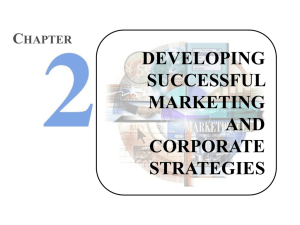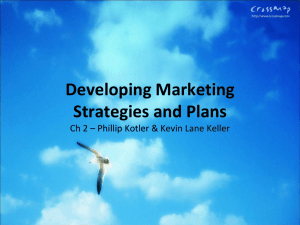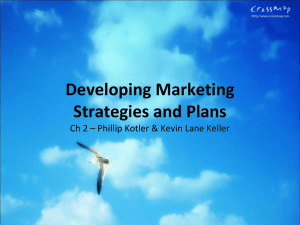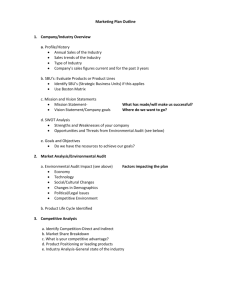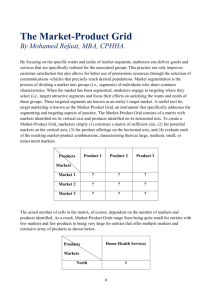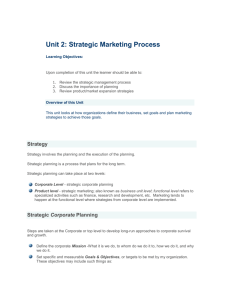Marketing and corporate strategies
advertisement
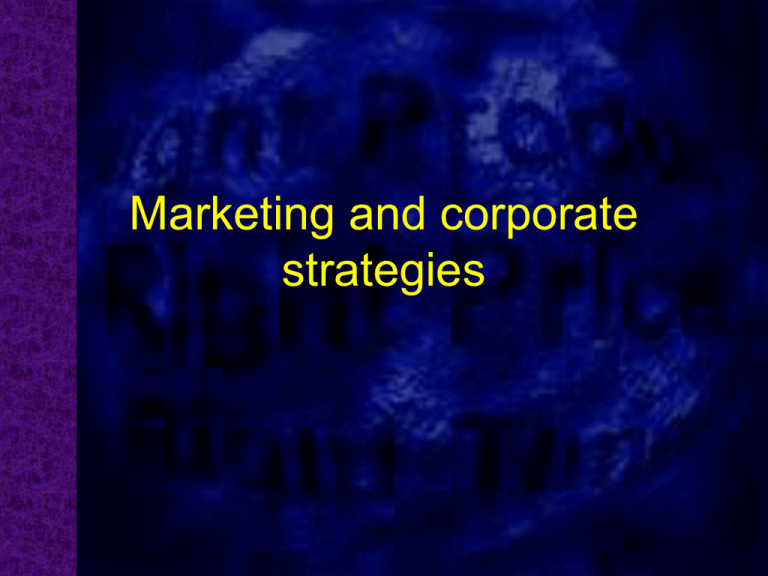
Marketing and corporate strategies Kinds of organizations • Profit organizations. A privately owned organization that serves its customers in order to earn a profit • Nonprofit organizations. A nongovernmental organization that serves its customers but does not have a profit as an organizational goal. Levels in organizations • Corporate level. Where top management directs overall strategy for the entire organization. • Business Unit Level. Level at which business unit managers set direction for their products and markets. • Functional level. Is where groups of specialists create value for the organization. (i.e. departments) Three levels of strategy in an organization Corporate strategy • Vision • Corporate goals • Philosophy and culture Business unit strategy • Mission • Business goals • Competencies Functional strategy Information systems Research & development Finance Manufacturing Marketing Human resources Combination of Customer Relationships The Organization’s Success Quality Customer Relationships Innovation Efficiency Strategy at the corporate level Corporate vision is . . . . a clear word picture of the organization’s future, often with an inspirational theme. It sets the overall direction for the organization, describing what it strives to be-stretching the organization, but not beyond reason. A goal is . . . . a targeted level of performance set in advance of work. Therefore, corporate goals provide strategic performance targets that the entire organization must reach to pursue its vision. Corporate goals may be articulated in terms of: - profits - quality - sales revenue - employee welfare - market share - social responsibility - unit sales Corporate Philosophy and Culture Corporate philosophy establishes the values and “rules of conduct” for running the organization. Corporate culture refers to a system of shared attitudes and behaviors held by the employees that distinguish it from other organizations. Strategy at the Business Unit Level Business Unit Mission and Goal The business unit mission is a statement that specifies the markets and product lines in which a business will compete. It communicates the scope of a business unit. A business unit goal is a performance target the business unit seeks to reach in an effort to achieve its mission. Goals that are more specific, measurable and quantifiable are called objectives. Boston Consulting Group Growth-Share Matrix 20% Question mark Market growth rate Star High ? A 10% D Low B Cash cow 0% 10x Dog C High 1x Low Relative market share (share relative to largest competitor) 0.1x Objectives for each SBU • Build. Increase market share through cash injection. Make Starts out of Question marks. • Hold. Maintain market share. Often used for Cash Cows which are already generating large amounts of cash • Harvest. Increase shortterm cash output of the SBU. Pump cash from Dogs or Cash Cows into Stars or Question Marks. • Divest. Sell the SBU. Question Marks and Dogs are ideal candidates Specifying the SBU’s Competencies: Some Important Definitions competitive advantage is . . . quality is . . . benchmarking is . . . . Strategy at the Functional Level Marketing and other functional departments create their own functional goals –really extensions of corporate and business unit goals. The Strategic Marketing Process • Where are we now? • Where do we want to go? • How do we allocate our resources to get where we want to go? • How do we convert our plans into action? • How do our results compare with our plans, and do deviations require new plans and actions? Marketing Plan • The strategic marketing process is usually formalized in a Marketing Plan, which is a road map for the marketing activities of an organization for a specified future period of time. The strategic marketing process Planning phase Situation (SWOT) analysis Market-product focus and goal setting Implementation Phase Results Control Phase Corrective Action Marketing plan Marketing program Planning phase Situation (SWOT) analysis Strengths Weaknesses Opportunities Threats Market-product focus and goal setting Marketing program •Market Penetration / New Markets •Product Development •Diversification Planning phase Situation (SWOT) analysis Market-product focus and goal setting Marketing program •Market Segmentation. Aggregating prospective buyers into groups, or segments that have: common needs and will respond similarly to a marketing action. •Selecting the target markets. •Finding points of difference for the product. (Competitive advantage) Planning phase Situation (SWOT) analysis Market-product focus and goal setting Marketing program •Developing the marketing mix (4 Ps) •Developing the budget Elements of the marketing mix that compose a cohesive marketing program Marketing manager Product Price Promotion Place Features Brand name Packaging Service Warranty List price Discounts Allowances Credit items Payment period Advertising Personal selling Sales promotion Publicity Outlets Channels Coverage Transportation Stock level Cohesive marketing mix Promotion Promotion Product Price Place Place Implementation Phase • The implementation phase involves executing the marketing plan and putting it into effect: – Obtaining resources (money and personnel) – Designing the marketing organization – Developing schedules – Executing the marketing program (strategy and tactics) Organization of a Typical Manufacturing Firm, Showing a Breakdown of the Marketing Department President Vice President Research and Development Department Manager Product Planning Vice President Manufacturing Department Manager Marketing Research Vice President Marketing Department Vice President Account and Finance Department Manager Sales Manager Advertising & Sales Regions and Representatives Sales Promotion Vice President Human Resources Department Strategy versus Tactics • Strategy means by which a goal is to be achieved, characterized by a specific target market and a marketing program to reach it • Tactics are detailed day-today operational decisions essential to the overall success of marketing strategies Control Phase • Comparing results with plans to identify deviations – Finding the planning gap • Acting on deviations – Performance less than expected – Corrective action – Performance greater than expected – Uncover the reason
